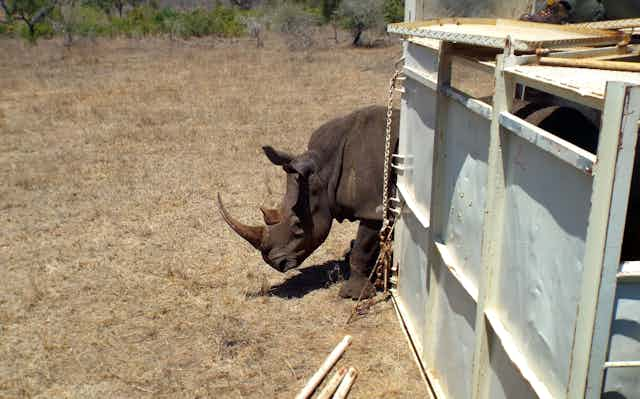Rhino poaching is one of the largest threats of the illegal wildlife trade. The animals are slaughtered for their horns, believed in some Asian cultures to have medicinal properties. Rhino populations across southern Africa are being decimated. As of August 27, 2015, 749 rhinos had been killed in eight months in South Africa alone.
One of the interventions that is being increasingly pursued is to translocate the animals. Across Africa rhinos are being translocated from national parks to private strongholds. Regular rhino translocations take place in South Africa and Namibia. Some rhino are moved annually in Zimbabwe, Kenya and Botswana, which have smaller populations.
South Africa has by far the largest rhino population in the world and does the most translocations globally. Both black and white rhino have been translocated in previous years to establish new populations and grow existing groups.
In 2014, more than 150 rhino were translocated by government and private initiatives. This is an active conservation strategy designed to protect the remaining animals, cut down on those lost to poaching and ensure the health and growth of future rhino populations.
Translocations typically take place in the drier and cooler months of the year. Rhino are darted from a helicopter. Blood and tissue samples are taken once the animal is immobilised. These samples can be used in poaching cases and for scientific research. The rhino is then walked into a crate and lifted by crane onto a flatbed truck to be transported to a new location.
The where and the why
Wildlife translocations can supplement small populations, replace animals that are lost to poaching or disease and re-introduce species into their former range. As most wildlife populations are now restricted to fenced parks and reserves, animals can no longer move into vacant areas on their own or disperse between populations for new breeding opportunities.
In the past, animals could also avoid dangerous areas, or leave a population that had become too large to be supported in that environment. As this can no longer happen naturally, park managers must ensure that the necessary movement of animals takes place.
The most obvious benefit to translocating rhino is protection from poachers. The sheer size of the larger game reserves make rhino vulnerable to poachers. Such extensive boundaries cannot be permanently policed.
Small reserves can be more thoroughly protected by rangers or private security. Movements within parks from high poaching zones to more heavily monitored protection zones can also give rhino a better chance of survival.

Moving animals promotes genetic health
Translocations can also be used as a conservation tool to increase the genetic health of a population and prevent inbreeding. This is particularly important in small populations. Genetics is a hugely important aspect to consider when translocating animals. Failure to do this can have serious impacts on the animals.
Genetic diversity is a measure of a populations’ genetic health. It represents the number of differences between the genetic code of individuals, which may enable the animals to cope better with disease or other environmental pressures. Large populations usually have a higher genetic diversity compared to small isolated populations. Small populations may have less variation and be more vulnerable to changing conditions.
Inbreeding happens when populations become too small and related animals are forced to breed with each other. This might not have an immediately negative impact, but may severely compromise the health and reproduction of future generations. This is known as inbreeding depression, and can put the survival and health of the whole population at risk in the long term.
Moving rhino from the Kruger National Park, which hosts the largest white rhino population in South Africa, takes new genes and diversity to other locations. Other populations in southern Africa have been isolated for some time and this will be an excellent way to re-introduce gene variants that were lost when small rhino populations were founded from just a few individual animals.
Long term commitment
Rhinos live for a long time. They can reach up to 40 years of age. This means that the removal of any single animal has a much greater impact. It isn’t just the individual animal that is lost, but all the offspring that would have been possible in the future.
This is particularly true for females of breeding age. These breeding females are essential for raising calves and the survival of the population. Increasing the number of females also promotes maximum growth in a population.
The planned movement and sale of rhino allows additional safeguards. Conditions can be included into purchase contracts to ensure that the benefits of translocation are maximised. For example, a commitment to breed the rhino as soon as they are introduced to their new environment ensures the population growth. Clauses that prevent hunting the translocated animals for a pre-determined time period also safeguard the animals for the future.
The South African National Parks rhino capture teams are extremely experienced with rhino capture and translocation. This commitment from conservation managers as well as governments and NGOs is vital for protection from poaching and to ensure the genetic health and growth of future rhino populations.
This article was written in collaboration with Dr Markus Hofmeyr, the head of Veterinary Wildlife Services at South African National Parks.


